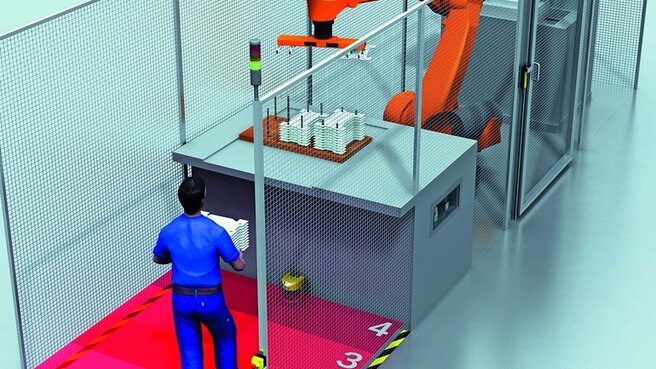Heavy-Duty robots become team players
Cobots have paved the way for human-robot collaboration (HRC). Currently, the trend is toward heavy-duty HRCs in industry, while lightweight robots are still in the trial and discovery phase.
The great enthusiasm for cobots, which made the rounds in the robotics world a few years ago, has clearly subsided. The small lightweight robots, which work together with people hand in hand in the same work area without elaborate protection spaces, are by no means built in the quantities that were predicted a few years ago.
Helmut Schmid, General Manager for Western Europe & Managing Director of the cobot manufacturer Universal Robots GmbH, remarked two years ago that “We already have a lot of applications on the market, but real HRC applications are only 10 to 20 percent of them.” This scenario has not changed fundamentally. This means that the lightweight robot is mainly used as a cost-effective solution and thanks to its simple integration and operation.
What are the reasons for this? “The often dominant picture at the beginning of the HRC discussion that humans and robots work closely together only makes sense in very few cases,” Professor Wilhelm Bauer, Head of the Fraunhofer ILO, emphasized.
Human workforce prevents fast ROI of cobots
“Collaborative robots are always advertised with the low investment compared to full automation. This is due to the fact that the expenditures for complex feeds as well as control and sensors can often be limited to the robot system,” Susanne Oberer-Treitz, Project Manager at Fraunhofer IPA. stated. “At the same time, however, most of the ongoing production costs of the overall system are retained in collaboration with humans. In this respect, HRC can only pay off if the added value of the application can be demonstrated, for example, by higher manufacturing quality.”
“The scope for cobots is currently still in the discovery phase. Especially in sectors such as medical technology and the aviation industry, the number of variants and the quality standards are often very high, so that humans and robots complement each other perfectly there,” Ralf Winkelmann, Managing Director of Fanuc Germany, confirmed.
The new trend: Heavy duty HRC
Nevertheless, experts assume that HRC will continue to play a role in the automation portfolio. “The developments in the cobotic sector are of course important and correct in the long term. In the short and medium term, however, a different type of human-robot collaboration is much more valuable for users and operators, namely the heavy-duty HRC,” Roland Schrattbauer, Robotics Program Manager at Austrian automation expert Keba, emphasized. Fraunhofer ILO Head Mr. Bauer agrees: “Omitting a fence and consequently achieving a new type of division of labor between robot and human is definitely a step forward.”
Four scenarios of collaborative operations
The “C” in HRC therefore stands not only for collaboration, but also for coexistence and cooperation – depending on how close the cooperation between humans and robot is. The range extends from coexistence (humans and fenceless robots work in neighboring areas, but have no common work space) to cooperation (humans and robots share a work space, but work in it at different times) to collaboration (humans and cobots have a common work space and work on the same component at the same time).
Accordingly, the ISO TS 15066 standard distinguishes four types of collaborative operation, the suitability of which depends on the requirements of the company for the application in terms of cycle time, flexibility and costs:
- Coexistence with a “safety-oriented monitored stop”. At “stop at access”, the robot moves within a specified working area. When the worker enters the cell, the robot stops. If the worker leaves the cell again, the robot restarts automatically.
- Cooperation through “distance and speed monitoring”. In this scenario, the robot stops when a defined safety distance is undershot. As soon as the safety distance is reestablished, the robot continues its movements. The slower the robot moves, the shorter the safety distance can be.
- Collaboration: “Power and force limitation” is used for direct interaction and close collaboration between humans and robots. Force and pressure that a cobot can exert on an employee are technically limited to a safe level. Force-limited, i.e., intrinsically safe cobots are normally used for this purpose.
- Manual guidance: A fourth scenario is manual guidance. There is a physical interaction there, in which the worker directly predetermines the movement. For example, manual guidance is suitable for robot programming or assisted positioning. Protective principles are the limitation of the robot speed and the active release of movement by a consent device.
Since collaborative robotics applications can be implemented not only with a power and force limitation, but also with speed and distance monitoring, some robot manufacturers do not develop special cobot models, but instead make their industrial robots fit for HRC with sensors or a protective safety skin. Advantage: The HRC-enabled industrial robots are not subject to any restrictions in terms of load capacity, speed, range and precision compared to pure cobot assistant robots.
HRC rethought as a unit of safety, security and privacy
Therefore, Werner Kraus, Head of Robotic and Assistance Systems at Fraunhofer IPA, argues in favor of “rethinking HRC” as a unit of safety, protecting a person from hazards caused by the function and malfunction of a technical system, security, protecting a system from deliberate attacks by people, and privacy, protecting a system from misconduct that endangers the informational self-determination of people.
Fanuc Managing Director Winkelmann is convinced: “To use industrial robots optimally together with humans, robots do not need new sensors, but rather new ideas and technologies are required for new production concepts. Camera-supported workspace monitoring and 5G can play an important role in this in the future.”






